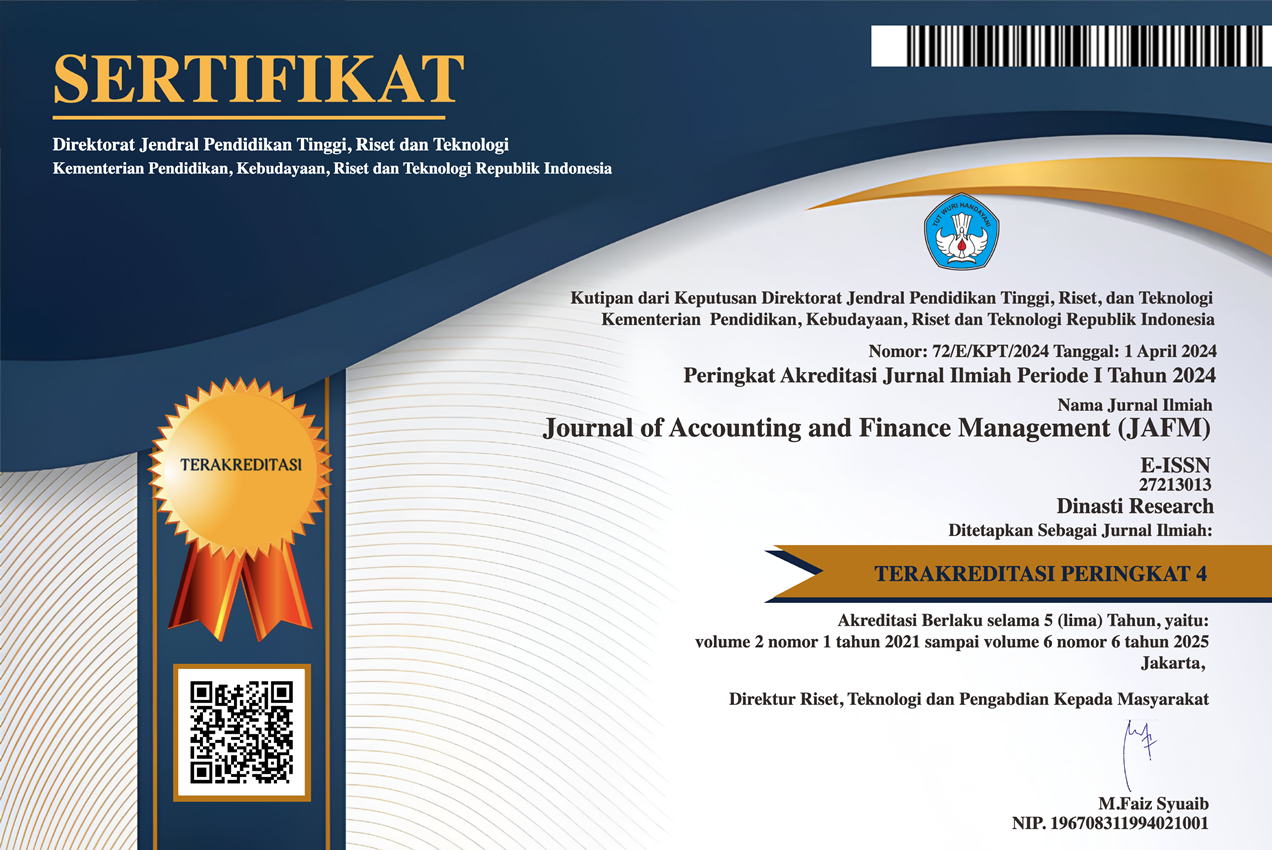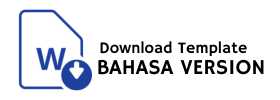The Effect of Return on Asset, Non Debt Tax Shield, Asset Growth, Company Size, and Current Ratio, Against Debt to Asset Ratio on Companies Consumer Goods Listed on Indonesia Stock Exchange for the Period (2011-2017)
DOI:
https://doi.org/10.38035/jafm.v1i3.20Keywords:
Return on Assets (ROA), Non debt tax shield (NDTS), asset growth (GROWTH), Size, Current Ratio (CR), Debt to Asset Ratio (DAR).Abstract
This research was conducted on Consumer Goods companies listed on the IDX (Indonesia Stock Exchange) for the period 2011 - 2017, aiming to examine the effect of Return on Assets (ROA), Non debt tax shield (NDTS), Asset Growth (GROWTH) Company Size (Size) , and Current Ratio (CR) simultaneously or partially to Debt to Asset Ratio (DAR). The sampling technique used was purposive sampling. The sample used in this study amounted to 26 companies, a total of 182 data. The data analysis technique in this research is multiple linear regression analysis, classic assumption test (normality, multicollinearity, heteroscedasticity, and autocorrelation), hypothesis testing, and the coefficient of determination. The software used for data processing is SPSS 22.0. The results of multiple linear regression analysis show the equation Ln_DAR = 2.119 - 0.041Ln_ROA + 0.091 Ln_NDTS + 0.0003 Ln_GROWTH - 0.030 Ln_SIZE - 0.565 Ln_CR + e with an F test of 103.468. The t-test value for the Return on Assets (ROA) variable is -2.529; the t-test value for the Non debt tax shield (NDTS) variable was 2,629; t test value for asset growth variable (GROWTH) is -0.014. t test value for variable firm size (Size) is -0.172; Current Ratio (CR) variable t test value of -21,437. The coefficient of determination (Adjusted R Square) is 0.739 or 73.9%, while the remaining 26.1% is influenced by other factors outside of this research model.
References
Chandra, Teddy. (2016). Debt in Indonesia. Zifatama Publishing, Sidoarjo.
Dang, V.A. (2013). Testing Capital Structure Theories Using Error Correction Models: Evidence From UK, France And Germany". Applied Economics45, pp 171-190
Dewi and Dana. (2017). Effect of Growth Opportunity, Liquidity, Non-Debt Tax Shield and Fixed Asset Ratio on Capital Structure. E-Journal of ManagementUnud.Vol. 6. No. 2.ISSN: 2302-8912.
Djumahir. (2012). The influence of the tax shield and non-tax shield variables on the capital structure and firm value. Vol. 8 No.3, pp. 302-321.
Fahmi, Irham. (2013). Financial Statement Analysis. Alfabeta, Bandung.
Firnanti, Friska. (2011). Factors Affecting the Capital Structure of Manufacturing Companies on the Indonesian Stock Exchange. Journal of Business and Accounting. Vol. 13 No.2, pp. 119-128.
Ghozali, I. (2016). Multivariate analysis application with the IBM SPSS 23 program. Publisher Agency. Diponegoro University, Semarang.
Harahap, S.S. (2010). Critical Analysis of Financial Statements. Jakarta: RajagrafindoPersada.
Hartoyo, Abiprayasa KW. (2014). Factors Affecting the Capital Structure of Textile and Garment Companies on the IDX. Accounting Analysis Journal.ISSN 2252-6765.
Hsiao, C. (2003). Analysis of Panel Data (2nd edition). Cambridge University Press.
Infantry, Riski Dian. (2015). Effect of Liquidity, Profitability on Capital Structure of Automotive Companies Listed on the IDX. Journal of Management Science and Research Vol. 4.No. 7.
Jantarakolica, Tatre. (2015). Determinants of Optimal Capital Structural of ASEAN Corporations.Rev. Integr. Bus. Econ.Res. Vol 4(3). ISSN: 2304-1013
Kasmir. (2015). Financial Statement Analysis. Jakarta: RajagrafindoPersada.
Margaretha, Farah and Ramadhan A.R. (2010). Factors affecting the Capital Structure in the Manufacturing Industry on the Indonesia Stock Exchange. Journal of Business and Accounting, Vol. 12. No.2, pp. 119-130.
Primantara, DityaYudi and Dewi M.R. (2016). The Effect of Liquidity, Profitability, Business Risk, Company Size, and Tax on Capital Structure. E-Journal of Management of Udayana University, Vol. 5, No. 5 ISSN: 2302-8912.
Sansoethan, DithyaKusuma. (2016). Factors Affecting Capital Structure In Food And Beverage Companies. Journal of Accounting Science and Research.Vol 5, No.1.
Sugiyono. (2010). Business research methods. Bandung: Alfabeta.
Sundari, Dwi and Susilowibowo, Joni. (2016). The Influence of Company Size and Non-Debt Tax Shield on Capital Structure in Sector Companies Finance. Journal of Management Science Vol.1.Number 1.
Sunyoto, Danang. (2013). Accounting Research Methodology. Bandung: RefikaAditama.
Syahara, Yayang Rita. (2015). The Existence Of Target Capital Structure And Speed Of Adjustment Evidence From Indonesia Public Firm. Proceedings Of International Conference On Management Finance Economics. ISSN: 9788193137307.
Widodo, M.W., Moeljadi and Djawahir, A.H. (2014). The Effect of Tangibility, Profitability, Company Growth, Non Debt Tax Shields, Cash Holding and Company Size on Company Capital Structure (Studies on Manufacturing Companies Listing on the IDX 2010-2012). Journal of Management Applications Vol. 12. No.1. ISSN: 1693-5241.
Downloads
Published
How to Cite
Issue
Section
License
Authors who publish their manuscripts in this journal agree to the following conditions:
- The copyright on each article belongs to the author(s).
- The author acknowledges that the Journal of Accounting and Finance Management (JAFM) has the right to be the first to publish with a Creative Commons Attribution 4.0 International license (Attribution 4.0 International (CC BY 4.0).
- Authors can submit articles separately, arrange for the non-exclusive distribution of manuscripts that have been published in this journal into other versions (e.g., sent to the author's institutional repository, publication into books, etc.), by acknowledging that the manuscript has been published for the first time in the Journal of Accounting and Finance Management (JAFM).




























